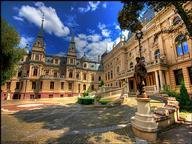Quiz Answer Key and Fun Facts
1. The first historical ruler of Poland, Mieszko I, is best known for joining Poland to the community of European Christian countries by getting baptized in 966. While a successful politician in many other fields, there was one goal he wasn't able to achieve before his death in 992. Which was it?
2. The Statute of Succession issued by Boleslaw III Wrymouth (reigned 1102-38) in 1138 included a provision which, though it may have appeared sensible to this duke of Poland, resulted in almost 200 years of decline for the Polish state.
What was it?
3. After a long period of fragmentation the Polish kingdom was reinstated by Wladyslaw the "Elbow-high" and rose to power during the reign of his son Casimir the Great who died leaving no legitimate successors, thus ending the Piast dynasty.
The Jagiellonian dynasty was established 15 years later after Krewo Union - a treaty between Poland and another country. Which?
4. Around 1439 Johannes Gutenberg invented printing by movable type. This was one of the many events that triggered the splits in Catholic Church known as the Reformation. Europe became a battleground for religious conflict, one of the most notable conflicts being the Thirty Years' War.
How was the Reformation handled in Poland?
5. After the death of the last Jagiellonian king, a new ruler had to be chosen. What method was adopted to determine who should be the next king of Poland?
6. The 16th and 17th centuries were anything but a calm period for Poland. It was involved in numerous campaigns and usually emerged victorious largely owing to one unit of paramount importance. This heavy cavalry was at the time considered the strongest in the world. What were these winged soldiers called?
7. By the beginning of the 21st century the Polish state had issued eight constitutions - the Constitution of 1997, Little Constitutions of 1992, 1947 and 1919, the April Constitution, the March Constitution, the constitution of People's Republic of Poland, and last but not least: the Constitution of the 3rd of May. In what regard was the 3rd May Constitution special?
8. Following many unsuccessful uprisings, with the end of World War I, Poland finally regained independence on 11th of November 1918. A newly reborn Polish country had yet to cope with numerous hardships.
Which of the following was NOT seen as a major problem at the time?
9. On the 1st September 1939 Nazi German army crossed the Polish border thus starting World War II. According to some speculations Poland was bound to fall sooner or later, while the others believe that it had a chance to defend if one particular event had not taken place. What was it that prematurely ended Polish struggle against the Nazis?
10. At the end of World War II Poland was included in the Soviet Block in accordance to Yalta and Potsdam agreements and became a Soviet satellite state called the People's Republic of Poland. In its short history numerous anti-government strikes took place, but the most widely known are those of Solidarnosc in early 1980s. These events eventually led to Roundtable Talks, the end of Soviet rule in eastern central Europe, the fall of Soviet Union and an end of the Cold War. But that's 1989 and the question is about 1981.
What was the socialist government's response to this anti-Soviet movement?
Source: Author
Markizxd
This quiz was reviewed by FunTrivia editor
bloomsby before going online.
Any errors found in FunTrivia content are routinely corrected through our feedback system.

